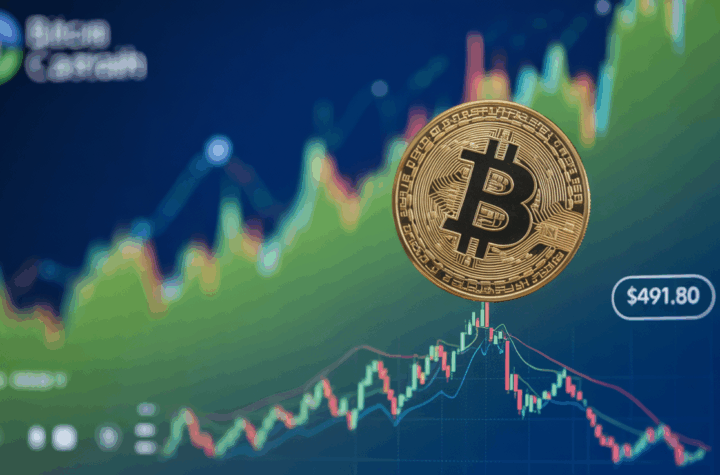
Asia Morning Briefing: Bitcoin Steady as Analysts Split on Outlook; Semler Scientific Eyes Massive BTC Hoard
PLUS: Presto Research argues crypto treasury firms pose less risk than feared.
Bitcoin (BTC) was trading above $104,500 as Asia markets opened Thursday, remaining relatively stable despite growing geopolitical tensions in the Middle East. Over the past week, BTC has edged down only about 2%, according to CoinDesk data, reflecting the market’s current low-volatility environment.
Yet analysts remain divided over whether this period of calm signals market strength—or a brewing storm.
Three new reports this week from CryptoQuant, Glassnode, and trading firm Flowdesk paint a similar surface picture: subdued volatility, narrow price ranges, and slowing on-chain activity. Retail involvement has dropped sharply, leaving institutional players like ETF managers and crypto whales in control of much of the market’s flow.
But among these analysts, CryptoQuant is sounding the loudest alarm.
In its June 19 report, CryptoQuant warned that BTC could slide back to $92,000—or possibly as low as $81,000—if demand continues to weaken. Despite some ongoing spot buying, the level remains far below historical norms. ETF inflows have plunged over 60% since April, while whale accumulation has been halved. Meanwhile, short-term holders, typically newer participants, have offloaded roughly 800,000 BTC since late May.
The firm’s proprietary demand momentum metric, which tracks directional buying across major cohorts, has sunk to negative 2 million BTC—its lowest level on record.
Glassnode, however, is far less pessimistic.
In its weekly on-chain report, Glassnode acknowledged lower transaction counts, reduced fees, and weaker miner revenues. But rather than reading this as a sign of weakness, the firm argues it reflects the network’s maturation. Settlement volumes remain significant but are increasingly concentrated in large-value transactions, signaling growing institutional and whale activity.
Glassnode also noted that derivatives markets now dwarf on-chain activity, with futures and options volumes exceeding spot trading by factors of 7x to 16x. That shift, the firm says, has introduced more sophisticated hedging, better collateral practices, and a more stable market structure, albeit less fueled by retail exuberance.
Flowdesk, meanwhile, strikes a middle ground.
The France-based market maker describes the current market as “coiled, not cracking.” While altcoin trading volumes have thinned out and market-making activity remains flat, Flowdesk sees bright spots. Tokenized assets like gold-backed XAUT have surged in volume, stablecoin activity is growing, and real-world asset (RWA) tokenization is on the rise.
According to Flowdesk, the subdued volatility could simply be the calm before a significant move—though not necessarily to the downside.
For now, uncertainty dominates. Even traders on Polymarket remain almost evenly split on whether BTC will fall to $90,000 in June or instead climb toward $115,000–$120,000.
One thing is clear: the ongoing tug-of-war between strong institutional adoption and fading retail enthusiasm leaves the door wide open for significant swings in either direction.
Presto Research: Crypto Treasury Firms Not Just “Leveraged Bitcoin ETFs”
In a separate development, Presto Research released a report arguing that Crypto Treasury Companies (CTCs)—such as Strategy and Metaplanet—are more sophisticated than merely acting as leveraged Bitcoin ETFs and may pose less risk than many investors assume.
Strategy’s recent $1 billion capital raise via perpetual preferred shares exemplifies how Bitcoin’s volatility can sometimes benefit these firms. Tools like perpetual preferreds, convertible bonds, and at-the-market (ATM) equity programs allow CTCs to aggressively acquire BTC without the margin risks that triggered past crypto collapses.
Presto highlighted that Strategy’s bitcoin holdings are unpledged and Metaplanet’s bonds remain unsecured, meaning forced liquidations—a major factor in previous crypto crises like Celsius and Three Arrows—are less of a threat here.
Still, the report notes that CTCs must navigate challenges around dilution, cash flow management, and precise capital timing. Metaplanet’s “bitcoin yield” metric, which tracks BTC per fully diluted share, underscores the focus on safeguarding shareholder value.
Handled wisely, these firms could earn net asset value (NAV) premiums, much like high-growth companies in traditional markets. But mismanagement could cause their financial engineering to backfire dramatically.
Semler Scientific’s Massive Bitcoin Ambition
Meanwhile, Semler Scientific (Nasdaq: SMLR) has unveiled one of the most ambitious bitcoin accumulation strategies in corporate history. The California-based medical device firm, which pivoted to a bitcoin treasury approach last year, aims to grow its holdings to 10,000 BTC by the end of 2025, 42,000 by 2026, and an astonishing 105,000 BTC by 2027.
That would more than double Semler’s current stash of 4,449 BTC in just 30 months.
The company plans to fund this expansion through a mix of equity sales, debt financing, and operational cash flow. Historically, Semler has relied on its ATM equity program to fund bitcoin purchases, which depends on its stock trading above net asset value.
However, Strategy-Tracker data shows that Semler’s market NAV multiple is currently just 0.859x, suggesting the firm’s shares are trading at a discount to the value of its BTC holdings. This could limit its ability to raise new capital at favorable terms.
Investors are watching closely to see how this dynamic plays out as the company ramps up its bitcoin acquisition plans. Despite bitcoin recently hitting new all-time highs above $100,000, Semler’s stock has dropped nearly 40% so far this year.
Market Snapshot
- BTC: Bitcoin remains capped below $105,000 despite strong ETF inflows. The market faces resistance at $105,150, with institutional buying offset by short-term bearish momentum and geopolitical uncertainty.
- ETH: Ethereum found support around $2,490 after a high-volume sell-off breached key levels. The price is consolidating in a narrow range, with a breakout possible if it can clear resistance at $2,510.
- Gold: Gold hovered near $3,366 on Thursday, largely unchanged as geopolitical concerns countered the Fed’s hawkish policy signals. Platinum pulled back after nearing a 10-year high, while U.S. markets were closed for the Juneteenth holiday.
- Nikkei 225: Japan’s Nikkei 225 opened 0.24% higher on Friday as Asia-Pacific markets mostly rose, ahead of China’s loan prime rate decision and ongoing tensions between Israel and Iran.






More Stories
“Dogecoin steadies near $0.16 support amid profit‑taking that caps upside momentum.”
RLUSD Pilot Boosts XRP 5%, Technical Momentum Points to $2.50
How Aggressively Are BTC Traders Hedging After Recent Dip Under $100K?